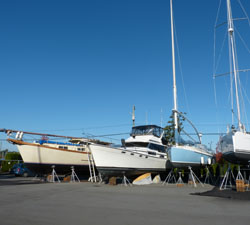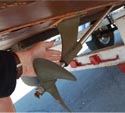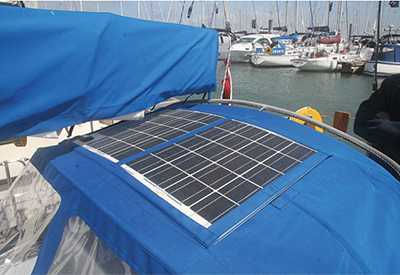Staying Connected

By: Glen Cairns
Room Available…Great View, Running Water – No Cell Service
Not many of us need to stay connected to our global business empire while cruising (the 0.01 %?), but a pretty sizeable percentage of boat owners do need to keep in contact whether for business or family reasons. In the not too distant past it was a big deal to clear your responsibilities and be able to take off for even afew weeks. However, connectivity for the average boater is improving and within the financial reach of most. These days, people simplyexpect to be able to contact you. Handled correctly, this ability to stay in touch can liberate you to cruise. Like so many of our modern conveniences,all this connectivity can be a double-edged sword. No one wants to sail with a skipper who spends the whole time on his/her phone.
This article is not for the techie boater, but rather an introduction for those who are just beginning to think about what is available. Exactly what equipment you will need depends on how much connectivity you want, where you plan to cruise, and of course, how much you are willing to spend.
At the most basic level is the need for Wi-Fi and cell service. Along many parts of the coast, cell service is quite good to within a couple of miles of the shore. With a good cell signal your smartphone can be set up as a Wi-Fi hot spot. Depending on the plan you have, your basic email, text, voice, and web browsingneeds can be met.
Nova Scotian sailmaker Michele Stevens has been cruising the Caribbean with her husband for the last few winters. Michele described her easy fix for maintaining simple, effective connectivity, “we unlocked an old iPhone 4 and then purchased a SIM card at each island with a data package. Then we can Bluetooth to our devices. We use this when travelling from island to island. We will reactivate our SAT phone when we are going to bring the boat back this winter, and then my husband, Al, can use it to connect to his computer to access weather files. But we will not be needing the internet for the max five days that we will be sailing between Puerto Rico and the Bahamas.We connect to my cell phone and iPad and Al’s cell phone and laptop.”
 As you can imagine, the best cruising locations are not always “communiction friendly”.
As you can imagine, the best cruising locations are not always “communiction friendly”.
Once in port, connecting to a Wi-Fi network is the easiest and cheapest option. Most marinas have Wi-Fi, but it can be spotty and weak as many people try to gain access at once.
Boost it. Even where Wi-Fi is available, the signal is often weak out on the docks, so some sort of Wi-Fi booster would be helpful. The simplest can be attached to a portlight or temporarily placed outside; however, it still needs line of sight. The next step is a Wi-Fi booster antenna mounted outside. This will increase the range but still requires a line of sight contact. There are numerous units on the market. Keep in mind simplicity and ease of installation to keep costs under control.
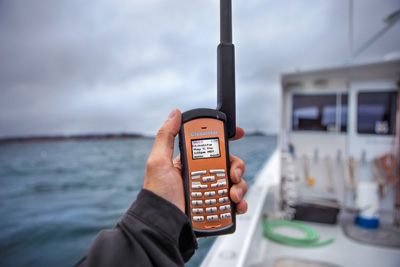 Globalstar considers the GSP 1700 sat phone its workhorse model, retailing for $499.
Globalstar considers the GSP 1700 sat phone its workhorse model, retailing for $499.
Here on Canada’s East Coast, marinas are few and far between, so it will be cell service you need to depend on, which is spotty along the coast once you are away from Halifax. Once you are away from any cell service or Wi-Fi, the answer is a satellite-based system. With these systems, the equipment and options you choose are only limited by your budget.
There are apparently over 1,000 communication satellites in orbit (plus another 2,500 or so dead ones!).Three main satellite systems, or constellations (as a group of satellites are called), dominate use for private communication.
Satellite systems in use:
Inmarsat
Inmarsat satellites orbit the earth directly over the equator at about 22,000 miles. The period of the orbit exactly matches the rotation of the earth, so they appear to be stationary over one spot. This system has been around for some time, and because the satellites always point to the same spot on earth, they require antennas that move in order to point to the appropriate satellite.
Iridium
Using 66 low earth orbit satellites, just 485 miles, the Iriduim system provides excellent coverage. The company is in the process of deploying a new series of 66 satellites (Iridium Next) with an emphasis on improved data transmission.This system provides worldwide coverage.
Globalstar
Like Iridium, the Globalstar constellation of 24 low earth orbit satellites (about 850 miles) provides satellite phone and low-speed data communications.This system does not have the same global coverage as the Iridium, but does cover North America, the Caribbean, and Europe. So for most users it is fine.
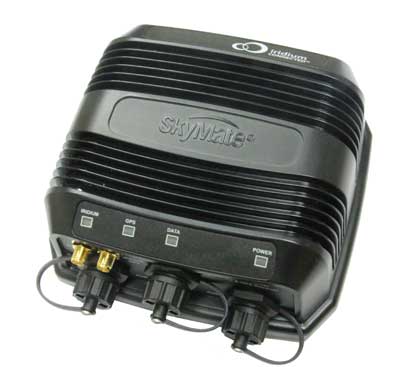 The Skymate Communications system is from Iridium.
The Skymate Communications system is from Iridium.
Because of the distance to the Inmarsat satellites, you get the two second delay we are familiar with when watching foreign correspondents nodding their heads on the evening news. As both Iridium and Globalstar have a low earth orbit, they do not have any delay.
Picking the right sat phone and plan can be a bit daunting as there are a myriad of them to choose from. In this regard, the satellite companies do not take a back seat to mobile suppliers.The main thing is to establish just how much communication ability you really need. Plans can get expensive quickly.
Finton Robb is marketing manager for Globalstar Canada. He points out that while there is rapid development in software applications, things move more slowly in the field of satellite communications. It takes a massive effort and financial investment to launch satellites. Finton says Globalstar has emerged as a leader with the launch of their low earth orbit satellites in 2013. Low earth orbit satellites give excellent voice quality with little or no time lag.
As an example,Globalstar considers the GSP 1700 sat phone its workhorse model,retailing for $499. Plans are flexible and can be purchased for short periods of time so you don’t pay for access you are not using.
Make your smartphone at lot smarter
The ubiquity of smartphones means that increasingly, people want to work with one device,with their smartphone being the primary device for information and communication. Both Globalstar and Iridium have released systems that allow you to use your smartphone for remote locations.
The Globalstar Sat Fi is a Satellite antenna connected to a Wi-Fi router. Apps are available for iOS, Android, Mac OS, and windows. Seasonal packages are available that allow the user to use minutes up front as needed.
Things are moving fast as companies respond to customer demands for easier and cheaper access to the internet. At present, most economical satellite communication systems are adequate for voice, text, and short emails; however, speeds and costs are not conducive to internet browsing.
Real world experience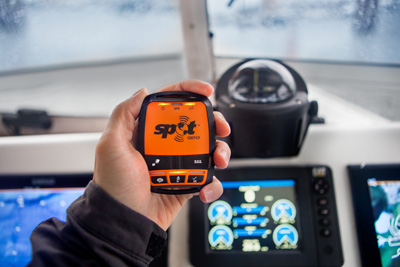 Spot Gen3 from Globalstar has been credited with thousands of rescues.
Spot Gen3 from Globalstar has been credited with thousands of rescues.
If you do not need voice communication, then more economical options are available to you. Bradd and Maeve Wilson have been living abroad and cruising full-time for the last 15 years and have covered some 70,000 miles. Having a solid business background and being a self-described “pretty thorough guy,” Bradd realized fellow cruisers could benefit from what he had. Bradd started Cruising Solutions to sell products the couple had tested themselves thathad proven successful. To run a successful business from their boat, the couple needed reliable and affordable communications, even when they were in remote areas such as the coast of Newfoundland. Since 2004, the couple has used the Iridium satellite based Skymate system when away from cell phone service and Wi-Fi. Bradd says the most recent version, the Skymate I1000, is easy to install, easy to use, and has proven reliable and affordable.
Skymate systems use the Iridium constellation of satellites and GPS satellites to provide email, weather, and position tracking weblog. The system works like a Wi-Fi router but is connected to a satellite network rather than a DSL or cable provider, and works with any Wi-Fi enabled device.
Safety first
Not everybody needs two-way communication. At the other end of the spectrum from the mega yacht satellite systems is SPOT from Globalstar. While it has a wide range of potential users, the SPOT line of products offers a simple and economical communication solution for small boat sailors. For many small boat cruisers, the most important consideration is safety when operating away from cell phone service. This equipment utilizes both the GPS system of satellites for location and Globalstar’s satellite constellation for communication of messages and GPS location. This allows you to make your location known to friends and family, and in the case of an emergency, rescue can be directed to your exact location.SOS capability is directed to an international rescue co-ordination centre. The company claims over 4,000 rescues. As Finton Robb remarks, “the SPOT Gen3 takes the search out of Search & Rescue.”
A case in point is the Nova Scotia Sea School (NSSS). For over 20 years they have been taking teenagers on open boat coastal cruises to teach survival and interpersonal skills. Each summer they take up to 11 youth on a coastal voyage aboard their two 30’ engineless open boats. The young people learn to navigate and cooperate on trips that usually last one week. This is a lot of responsibility for the instructors. Heather Kelday, the NSSS executive director, commented that, “… we [NSSS] have a robust emergency action and risk management plan.We use a fair amount of redundancies and communication tools. All our staff are trained in communications. One staff member always carries SPOT in their PFD (personal flotation device). Staff also perform daily check-ins so we know where they have anchored for the night.”
Part of basic list of safety equipment
The Spot Gen3 and others like it, such as the Garmin InReach, are targeted to the small boat user (or anyone off the beaten track). Whether it’s for a kayak trip or small open boat cruise, the ability for others to track your location is a huge step forward for safety. Now everyone who ventures away from populated areas should do so with common sense and careful preparation. The availability of rescue is no excuse for irresponsible behaviour. That said, the major expense in any rescue operation is typically the extended search.
The main takeaway here is that the choices for internet and voice communications are many and varied, meaning a combination that fits your needs is within your reach. While the choices grow, the cost of communication is coming down.
www.globalstar.ca
www.iridium.com
www.skymate.com
www.cruisingsolutions.com


